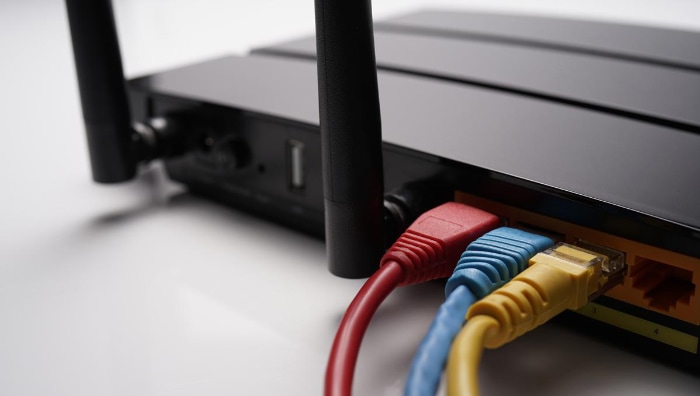Dual-Band vs. Tri-Band: How to Choose

Choosing the right router can be a pivotal decision in setting up a seamless and efficient home network. Routers act as the backbone of your digital life, enabling everything from streaming your favorite shows to participating in crucial video conferences.
Yet, not all routers are created equal. Specifically, dual-band and tri-band routers offer different levels of performance, complexity, and suitability for various types of online activities.
The Fundamentals of Band Frequencies
Wireless networking technology has seen exponential growth in the past decade, leading to multiple options for consumers. One of the most critical aspects to consider when choosing a router is the band frequencies it operates on.
The available bandwidth and speed of your network rely heavily on this factor.
What are Band Frequencies?
Band frequencies refer to the range of radio waves that a wireless router uses to communicate with connected devices. In simpler terms, these frequencies act as the lanes on a highway, allowing data packets to travel between your router and your devices.
The more lanes you have, the less likely it is for traffic to congest, leading to a smoother experience.
The 2.4 GHz Band
One of the most common bands, the 2.4 GHz band, offers three non-overlapping channels and is best suited for long-range communication.
It’s widely used and provides compatibility with a vast array of devices, including older models. However, its widespread use also makes it susceptible to congestion and interference from other devices such as microwaves and cordless phones.
The 5 GHz Band
On the flip side, the 5 GHz band offers up to 23 non-overlapping channels, resulting in less congestion and greater potential for higher data rates. This band is ideal for tasks that require higher bandwidth, such as video streaming or online gaming.
However, it is worth noting that the range of the 5 GHz band is generally shorter than the 2.4 GHz band, and it may have compatibility issues with older devices.
Dual-Band vs. Tri-Band: The Additional 5 GHz Band
Tri-band routers introduce an extra 5 GHz band to the equation. This additional band acts as another lane on the data highway, designed to further alleviate congestion when multiple devices are connected.
The presence of an extra 5 GHz band essentially splits the connected devices into two separate networks, reducing competition for bandwidth and theoretically improving performance.
Why Band Frequencies Matter
Choosing between dual-band and tri-band routers ultimately boils down to your specific needs in terms of speed, range, and the types of activities you typically perform online. Band frequencies are the building blocks of your wireless network, and the number of bands a router has will directly impact its performance and how well it can manage multiple devices.
Key Differences Between Dual-Band and Tri-Band
When you’re in the market for a new router, you’re likely to come across terms like dual-band and tri-band quite frequently. These terms refer to the number of separate frequency bands that a router can operate on simultaneously.
Knowing how dual-band differs from tri-band can be crucial for maximizing your network’s potential.
Speed and Bandwidth Capabilities
One of the most noticeable differences between dual-band and tri-band routers lies in their speed and bandwidth capabilities. Dual-band routers typically operate on the 2.4 GHz and 5 GHz bands.
This allows for a decent mix of range and speed but may limit the number of high-demand activities you can perform at once. Tri-band routers, with their additional 5 GHz band, offer more channels for data to travel through, effectively increasing the available bandwidth and potential speed for multiple devices.
Suitability for Varied Online Activities
Different online activities require varying levels of bandwidth. For example, casual browsing or sending emails does not require as much bandwidth as streaming 4K videos or playing data-intensive video games.
Dual-band routers can sufficiently handle low to medium-demand activities but may struggle when multiple devices are running high-demand applications simultaneously. Tri-band routers, with their extra 5 GHz band, are better equipped to handle such scenarios, making them ideal for homes with multiple users engaging in different high-bandwidth tasks.
Cost Considerations
There’s a notable difference in price between dual-band and tri-band routers. Dual-band routers are generally more budget-friendly and offer good value for small to medium-sized homes with moderate internet usage.
Tri-band routers tend to be more expensive due to their additional features and capabilities, making them a significant investment that you should weigh carefully against your actual needs.
Compatibility and Device Management
Both dual-band and tri-band routers are compatible with devices that can connect to either the 2.4 GHz or 5 GHz bands. However, tri-band routers offer better device management by providing an additional 5 GHz band.
This extra band allows you to distribute your devices more evenly across the bands, thereby reducing network congestion. This can be especially beneficial in large households with numerous connected devices.
Future-proofing Your Network
While dual-band routers can satisfy current needs for many users, tri-band routers offer a degree of future-proofing. As more devices become internet-enabled and applications require greater bandwidth, having an extra 5 GHz band could provide a cushion against potential network congestion and performance issues in the coming years.
Pros and Cons of Dual-Band Routers

Making an informed decision about which router to purchase involves considering both the advantages and disadvantages of your options. Dual-band routers, which operate on 2.4 GHz and 5 GHz bands, have been a mainstay in homes for several years.
Lower Cost
One of the most compelling advantages of dual-band routers is their affordability. These routers are generally priced lower than their tri-band counterparts, making them an attractive option for budget-conscious consumers.
The reduced cost doesn’t necessarily mean compromised performance; dual-band routers often provide a good balance of speed and range suitable for many users.
Sufficient for Small to Medium Homes
Dual-band routers are generally adequate for small to medium-sized homes. With fewer walls and devices to contend with, the 2.4 GHz and 5 GHz bands can offer a reliable and smooth online experience for activities like browsing, streaming, and casual gaming.
Compatibility with Older Devices
Dual-band routers are versatile in terms of device compatibility. The 2.4 GHz band is excellent for older devices that may not support the faster 5 GHz band, ensuring that all your gadgets can connect without issues.
Limited Bandwidth for Multiple Devices
One of the significant drawbacks of dual-band routers is the limitation in bandwidth when multiple devices are connected. With only two bands, these routers can experience congestion, leading to slower speeds and potential lag during high-demand activities.
Interference in Crowded Environments
The 2.4 GHz band is notoriously crowded, not just with Wi-Fi but also with other devices like microwaves and cordless phones. In densely populated areas, this can lead to interference and a less stable connection.
Less Optimal for High-Bandwidth Tasks
Dual-band routers are less suited for high-bandwidth tasks like 4K streaming, especially when multiple devices are in use. The available bandwidth might not suffice, leading to buffering or lag.
Pros and Cons of Tri-Band Routers
As internet usage continues to evolve, tri-band routers have gained popularity for their enhanced capabilities.
Better Bandwidth Allocation
With an additional 5 GHz band, tri-band routers are capable of managing a larger number of devices more efficiently. The extra band allows for better bandwidth allocation, ensuring that high-demand activities get the resources they need for optimal performance.
Ideal for High-Demand Networking Tasks
Tri-band routers excel in environments where high-demand networking tasks are common. Whether it’s 4K video streaming, competitive online gaming, or large file downloads, the extra 5 GHz band provides the necessary bandwidth to handle these activities smoothly.
Suitable for Larger Homes with Multiple Devices
For households with a large number of connected devices, a tri-band router offers the added benefit of distributing network traffic more effectively across its bands. This reduces the risk of network congestion, making it an excellent choice for large homes.
Higher Cost
One of the main downsides of tri-band routers is their higher cost. The added features and capabilities come at a premium, so it’s important to evaluate whether your home network requires such advanced hardware.
Potential Overkill for Low-Demand Users
If your internet usage is limited to basic tasks like web browsing, email, and occasional video streaming, a tri-band router might be overkill. The extra band may remain underutilized, making the additional investment unnecessary.
Compatibility with Older Devices
While tri-band routers offer better bandwidth allocation and speed, they are not always the best fit for older devices that only support 2.4 GHz. In such cases, these devices will connect to the 2.4 GHz band, not benefiting from the additional 5 GHz band and potentially causing congestion on that band.
Real-World Scenarios: Which One is Better for You?
Choosing between a dual-band and a tri-band router often involves more than just weighing pros and cons; it also includes evaluating how well each type suits your specific real-world needs. Various scenarios can influence your choice, from the number of connected devices in your household to your typical online activities.
Small Apartment with Basic Internet Needs
In a small apartment where the internet usage is relatively low-key—think web browsing, social media scrolling, and occasional video streaming—a dual-band router is often sufficient. The 2.4 GHz and 5 GHz bands can easily handle these activities without noticeable lag, making it a cost-effective and efficient choice.
Larger Home with Multiple Users
If you live in a larger home with multiple family members who have varied online needs, a tri-band router can be more fitting. The additional 5 GHz band helps distribute the network load more effectively, ensuring that everyone can stream, game, and browse without hampering each other’s online experience.
Remote Work or Online Schooling
For homes where multiple people are engaging in remote work or online schooling, a tri-band router may provide the robust and reliable connection required. Video conferencing, large file downloads, and constant connectivity need more bandwidth, which the extra 5 GHz band can supply efficiently.
Gamers and Streamers
In a household where high-definition gaming and 4K streaming are common, a tri-band router is usually the better choice. These activities require high bandwidth and low latency, conditions that the extra 5 GHz band in a tri-band router is designed to meet.
Older Devices in the Network
If your home network consists of a mix of new and old devices, a dual-band router may offer the compatibility you need. The 2.4 GHz band can serve older devices that do not support 5 GHz frequencies, while the 5 GHz band can handle newer, more demanding devices.
Budget Constraints
For those who are budget-conscious but still want a reliable internet experience, dual-band routers offer a good compromise. They provide a blend of speed and range that is adequate for most basic to moderate internet activities without breaking the bank.
Infrequent Internet Usage
If your household does not rely heavily on the internet, investing in a high-end tri-band router may not be necessary. A dual-band router should suffice for occasional browsing, email checks, and low-definition video streaming.
Conclusion
Selecting the right router hinges on multiple factors, ranging from your home’s size and the nature of your online activities to the types of devices you own. While dual-band routers offer affordability and are often adequate for small to medium homes with moderate internet usage, tri-band routers excel in environments with high-demand networking tasks and multiple devices.
Each type has its pros and cons, as well as varying performances across different real-world scenarios. Your ultimate choice should align with your specific internet requirements and budget constraints, ensuring a reliable and efficient online experience tailored to your needs.


